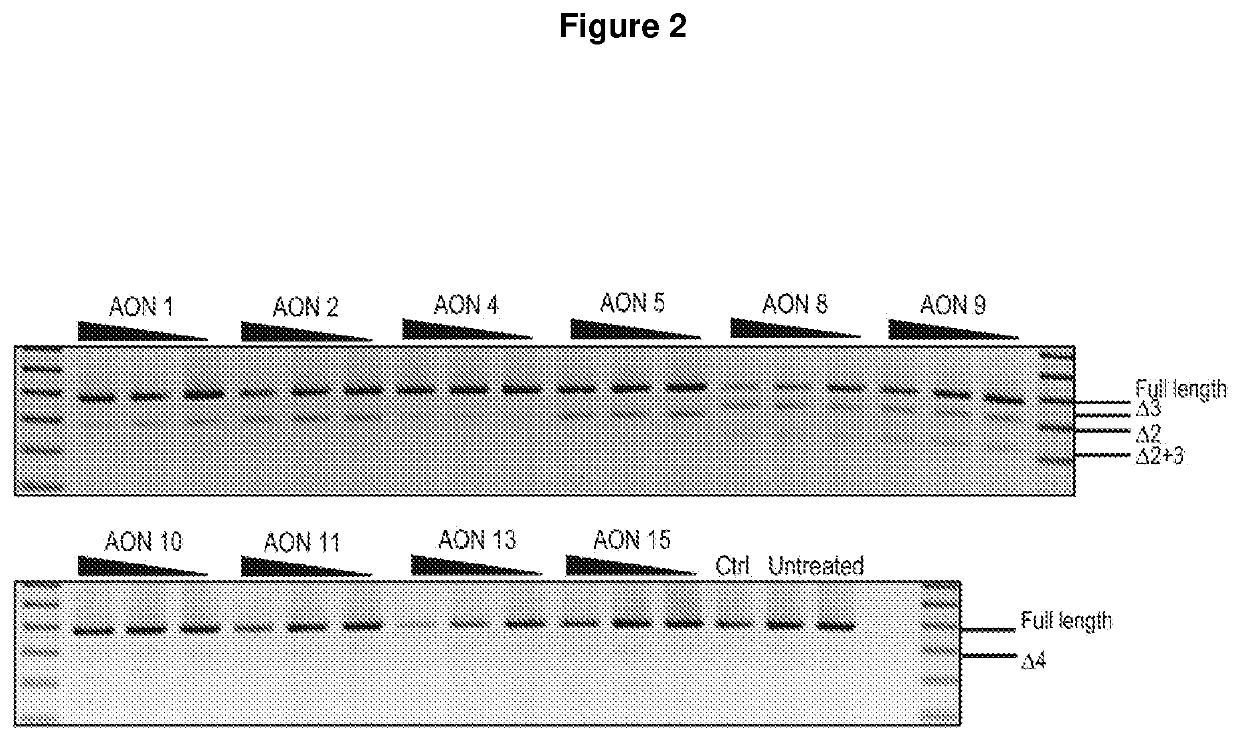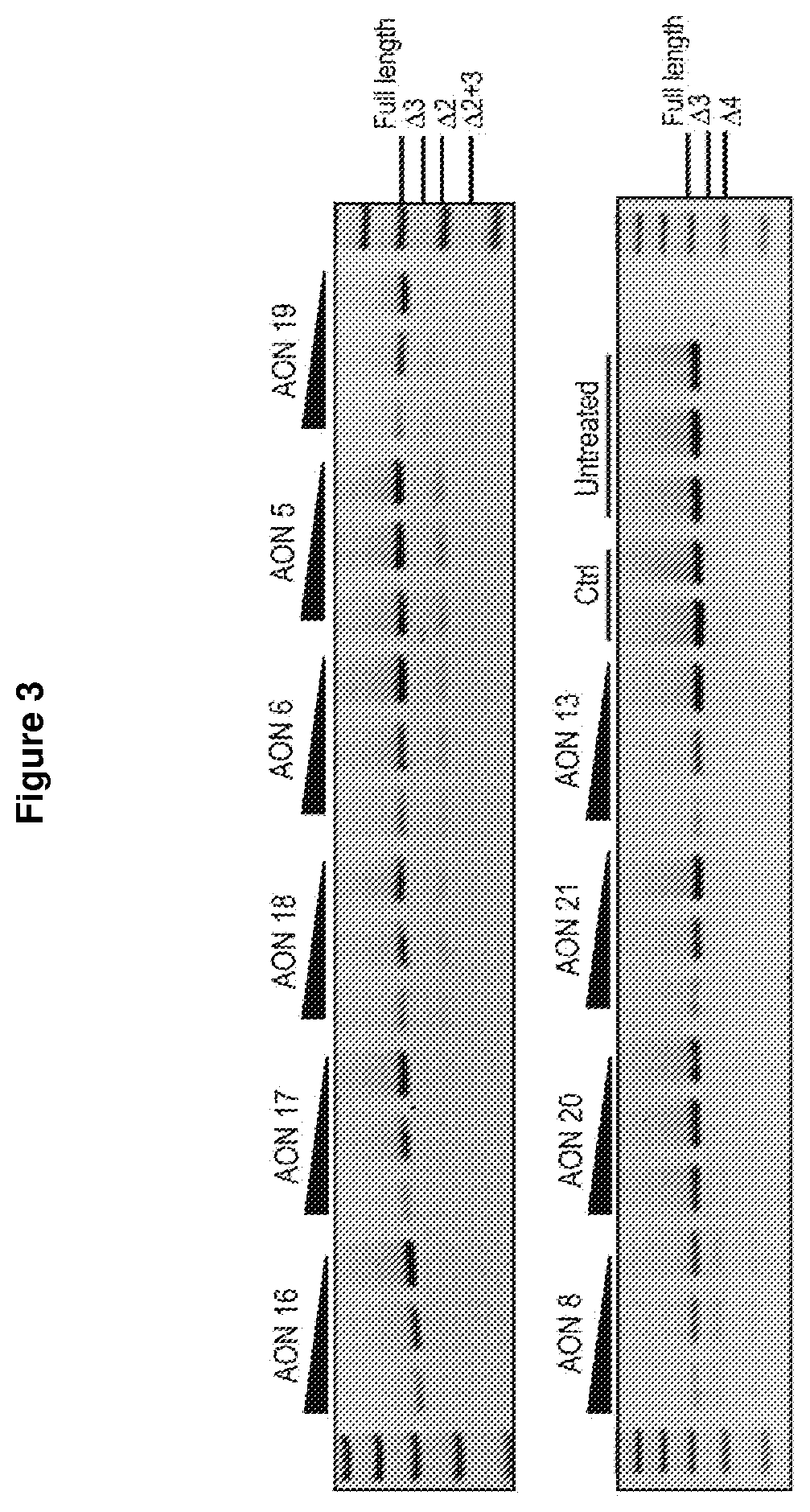Treatment for sod1 associated disease
a sod1 and associated disease technology, applied in the field of antisense oligonucleotides, can solve the problems of oxidative stress, neuronal oxidative stress is particularly prone to oxidative stress, and large amount of superoxide radicals
- Summary
- Abstract
- Description
- Claims
- Application Information
AI Technical Summary
Benefits of technology
Problems solved by technology
Method used
Image
Examples
example 1
Original AONs
[0221]Splice-switching AONs were designed to target the 5′ and 3′ splice sites and exon splice enhancer sites within the exon as predicted by online splice prediction tools.
[0222]The sequences for these original AONs are listed in Table 1, as SEQ ID NO 3, 5, 7, 9, 12 and 14. AON nomenclature was based on that described by Mann et al. (Mann et al, J Gene Med., 2002 4 (6), 644-654), whereby the species, gene, exon number, acceptor or donor targeting and annealing coordinates are described, where “−” indicates intronic position and “+” specifies exonic location from the splice site, as described herein. Some detailed oligomer annealing coordinates are shown in Table 1. FIG. 12 sets out a schematic diagram of the binding location of each of the AONs on SOD1.
[0223]AONs with 2′OMethyl modifications and a phosphorothioate backbone were ordered from TriLink Biotechnologies, Inc (San Diego, Calif., USA). PMOs with a phosphorodiamidate backbone were ordered from Genetools LLC (Ph...
example 2
ning Using Transcript Analysis
[0224]RT-PCR analysis of the SOD1 transcript was conducted following transfection of 2′OMethyl AONs (50, 25 and 12.5 nM). The level of SOD1 exon skipping following AON transfection was compared to that of a sham control treated and untreated sample.
Materials and Methods
Transfection of Fibroblasts
[0225]Normal human dermal fibroblasts were propagated according to established techniques with 15,000 cells seeded into 24 well plates in 10% FBS DMEM and incubated at 37° C. for 24 hours prior to transfection. All 2′OMethyl PS-AOs were transfected using Lipofectamine 3000 (3 μl per ml of transfection volume) (Life Technologies, Melbourne, Australia), according to manufacturer's protocols, and AO transfected cells incubated for 24 hours.
Transcript Analysis
[0226]RNA was extracted using the MagMAX-96 Total RNA Isolation Kit, including a DNase treatment (Life Technologies), according to the manufacturer's instructions. RT-PCRs were performed using the One-step Supe...
example 4
ion of AONs
[0229]Following AON screening, AONs targeting SOD1 exons 2, 3 and 4 were optimised by micro-walking, and the level of exon skipping following transfection was compared to the original AON sequence, a sham control AON and untreated samples.
[0230]The AON sequences were moved up or down stream by 3 to 5 bases to identify the optimal target site, while still maintaining oligomer length. Further optimisation was carried out by varying the AON length between 20 to 25 nucleotides.
[0231]FIG. 2 shows RT-PCR analysis of following sequence optimization, compared to the original AON sequence, a sham control and untreated samples. FIG. 3 shows the results of further optimization for AONs designed to target the donor site of exon 1, and the levels of full-length SOD1 transcript compared to that of sham control and untreated samples.
[0232]AONs 1 to 5 (which correspond to SEQ ID NOs 1 to 5 in Table 1) were designed to induce exon 2 skipping. Of these AONs, AON 5 targeting the exon 2 dono...
PUM
| Property | Measurement | Unit |
|---|---|---|
| Tm | aaaaa | aaaaa |
| Tm | aaaaa | aaaaa |
| temperatures | aaaaa | aaaaa |
Abstract
Description
Claims
Application Information
 Login to View More
Login to View More - R&D
- Intellectual Property
- Life Sciences
- Materials
- Tech Scout
- Unparalleled Data Quality
- Higher Quality Content
- 60% Fewer Hallucinations
Browse by: Latest US Patents, China's latest patents, Technical Efficacy Thesaurus, Application Domain, Technology Topic, Popular Technical Reports.
© 2025 PatSnap. All rights reserved.Legal|Privacy policy|Modern Slavery Act Transparency Statement|Sitemap|About US| Contact US: help@patsnap.com



